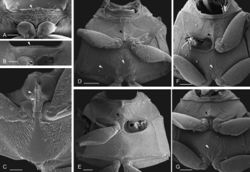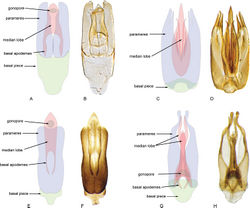Acidocerinae
| Notice: | This page is derived from the original publication listed below, whose author(s) should always be credited. Further contributors may edit and improve the content of this page and, consequently, need to be credited as well (see page history). Any assessment of factual correctness requires a careful review of the original article as well as of subsequent contributions.
If you are uncertain whether your planned contribution is correct or not, we suggest that you use the associated discussion page instead of editing the page directly. This page should be cited as follows (rationale):
Citation formats to copy and paste
BibTeX: @article{Girón2021ZooKeys1045, RIS/ Endnote: TY - JOUR Wikipedia/ Citizendium: <ref name="Girón2021ZooKeys1045">{{Citation See also the citation download page at the journal. |
Ordo: Coleoptera
Familia: Hydrophilidae
Name
Zaitzev, 1908 – Wikispecies link – Pensoft Profile
- Acidocerini Zaitzev, 1908: 353, as subfamily.
- Acidocerina as subtribe Acidocerina [of tribe Hydrophilini, subfamily Hydrophilinae] in Hansen (1991[1]: 282; 1999b[2]: 155).
- Acidocerina as tribe [of subfamily Hydrophilinae] in Short and Fikáček (2011[3]: 85).
- Acidocerina as subfamily in Short and Fikáček (2013[4]: 741).
- Helopeltini Horn, 1873: 118; synonymized by Hansen (1991[1]: 282); unavailable: generic name is preoccupied (ICZN 1999, Code Art. 39).
- [[ | ]] Type genus: Helopeltis Horn, 1873: 137 [synonym of Helobata Bergroth, 1888: 221].
- [[ | ]] Helocharae d’Orchymont, 1919c: 147; described as subtribe, synonymized by Hansen (1991[1]: 282).
- [[ | ]] Type genus: Helochares Mulsant, 1844a: 197.
- Horelophopsinae Hansen, 1997: 108.
- [[ | ]] Type genus: Horelophopsis Hansen, 1997: 109; synonymized by Short and Fikáček (2013[4]: 15, in table, discussed along the text).
- Globulina García, 2001: 153; emended to Globulosina by Short and Hebauer (2006[5]: 338); synonymized with tribe Acidocerini by Short and Fikáček 2011[3]: 84.
- [[ | ]] Type genus: Globulosis García, 2001: 153.
Type genus
Acidocerus Klug, 1855: 649.
Diagnosis
Body length 1.2–14.0 mm. Body shape oval in dorsal view, dorsoventrally flattened, or weakly to strongly convex in lateral view (Fig. 1); surface even (without elevations or depressions), granulate (e.g., Figs 17, 33) or smooth on head and pronotum. From yellowish to dark brown in coloration (Fig. 1), usually uniform, sometimes different regions of body colored differently. Shape of head variable (trapezoid, subquadrate, round; Fig. 11E–L). Anterior corners of frons sometimes extended posteriorly forming canthus and emarginating anterior margin of eyes (e.g., Tobochares, Helobata; e.g., Fig. 11B, C). Eyes varying in size, shape, degree of emargination, and degree of projection from outline of head (Fig. 11E–L); absent only in cavernicolous genus Troglochares Spangler, 1981a. Clypeus variable in shape (rectangular to trapezoid; Fig. 11E–L), with anterior margin from straight to mesally emarginate. Labrum usually exposed; concealed by clypeus in Helobata (Fig. 11L) and Helopeltarium (Fig. 1H). Mentum usually wider than long, with strong median anterior depression, may be limited by low transverse carina (Fig. 12A–C); surface of mentum with variable sculpture, ranging from smooth (Fig. 12A) to roughly punctate or obliquely striate (Fig. 12B). Antennae with eight or nine antennomeres (Fig. 12D, E), with cupule varying in symmetry and shape. Maxillary palps curved inward, ranging from very short (nearly half width of the head; e.g., Quadriops reticulatus, Fig. 12C) and stout, to very long and slender (nearly twice the width of the head; e.g., Peltochares, Fig. 11K). Pronotum evenly convex, usually with systematic punctures forming paired anterolateral semicircles and paired short posterolateral transverse bands. Elytra with or without sutural striae, with outer margins simple, slightly flared, or laterally explanate; elytral punctation variable (Fig. 13). Hind wings usually well developed (Fig. 15A–F), seldom reduced along apical region (Fig. 15G). Surface of prosternum flat (e.g., Fig. 14A, B), convex or rarely medially carinate (e.g., Crucisternum; Fig. 29C), with anterior margin straight or anteriorly projected. Posterior elevation of mesoventrite either only weakly bulging or with transverse (e.g., Fig. 14E, G) or longitudinal ridge (e.g., Fig. 14D, F); with strongly produced, anteriorly pointed and longitudinally carinate transverse ridge in Crucisternum (Fig. 14C). Anapleural sutures variable in shape and orientation. Metaventrite rather uniformly covered by hydrofuge pubescence (e.g., Fig. 14E), sometimes with posteromesal glabrous patch (e.g., Fig. 14D, F, G), sometimes also with posterolateral glabrous patches (e.g., Fig. 14D). Protibiae with anterior row of spines varying in shape and development; apical spurs of protibiae varying in development. Metafemora with tibial grooves of varying development; hydrofuge pubescence on anterior surface of metafemora absent, reduced to only basal or dorsal patch, or increasingly covering most of surface. Tarsomeres 5-5-5; tarsomeres variable in size, proportions, and dorsal and ventral coverage. Abdomen with five pubescent ventrites, density of setae ranging from sparse to very dense. Fifth abdominal ventrite with apex either rounded (Fig. 15I), truncate (Fig. 15J), or emarginate (Fig. 15H); apex with or without fringe of flat and stout setae. Aedeagus usually symmetrical (Fig. 16), with basal piece varying in size from longer than parameres (e.g., Primocerus, Fig. 47; Batochares, Fig. 22D), to reduced and virtually absent (e.g., Peltochares, Fig. 45); parameres highly variable in shape, either slender and only connected to each other at base of ventral surface (e.g., Fig. 16A–D, G, H), or fused together forming tube-like structure (e.g., Fig. 16E, F); apex of parameres either simple, or bifurcated and modified with hooks and spines (e.g., Fig. 16C, D); median lobe either simple or with dorsal and ventral lobes, with well-developed lateral basal apodemes; further modifications (longitudinal divisions, presence of internal hooks and spines, development of gonopore) widespread.
Differential diagnosis
Acidocerines can be generally recognized by their oval and moderately convex body shapes with slender maxillary palps and uniformly slender tibiae (usually strongly convex and sometimes rounded in Cylominae and Sphaeridiinae, with short and stout maxillary palps and stout to apically broadened tibiae). The maxillary palps are always curved inwards in Acidocerinae (maxillary palpomere 2 with inner margin straight to concave; Fig. 12F–J), with palpomeres 2–4 similar in length and proportions (curved outwards, zig-zag oriented, or with shorter palpomere 3 in most Enochrinae and Chaetarthriinae). In addition, Acidocerines always bear five tarsomeres on the meso- and metatarsi (four in some enochrines).
Selected references
Hansen 1991[1]: diagnosis of the group (at the time as a subtribe, and including some genera now placed in the subfamily Enochrinae), list of genera and subgenera with synonyms, key to genera, and description of each genus (8 out of the 23 recognized in this paper). Hansen 1999b[2]: catalog with full list of species at the time (nearly 300), synonyms and references. Short and Fikáček 2013[4]: Acidocerinae as a subfamily excluding enochrine genera, with Horelophopsinae as synonym, list of genera, general diagnosis. Short et al. (2021)[6]: molecular phylogeny and biogeography of the subfamily, groups of genera.
Remarks
The subfamily Acidocerinae is a group with many contrasts. It includes some of the largest as well as smallest hydrophilids; some genera are either strikingly different from, or extremely similar to others; the external morphology of some genera is extremely uniform and species can only be recognized by characters of the male genitalia, or so variable that is difficult to diagnose the group as a unit; at the species level, the distributions can be very narrow and restricted to one or a few fairly close localities, or very broadly widespread across several continents. There is a trend for species living in the same kind of habitats to have certain shared morphological features. For example, species that live in aquatic habitats tend to have slender and relatively long maxillary palps and metafemora mostly covered by hydrofuge pubescence, whereas species living in hygropetric habitats tend to have shorter and stouter maxillary palps and reduced or absent coverage of hydrofuge pubescence on the metafemora.
Taxon Treatment
- Girón, J; Short, A; 2021: The Acidocerinae (Coleoptera, Hydrophilidae): taxonomy, classification, and catalog of species ZooKeys, 1045: 1-236. doi
Images
|
Other References
- ↑ 1.0 1.1 1.2 1.3 Hansen M (1991) The hydrophiloid beetles. Phylogeny, classification and a revision of the genera (Coleoptera: Hydrophilidae).Biologiske Skrifter40: 1–367.
- ↑ 2.0 2.1 Hansen M (1999b) World catalogue of insects (Volume 2). Hydrophiloidea (s. str.) (Coleoptera).Apollo Books, Stenstrup, 414 pp.
- ↑ 3.0 3.1 Short A, Fikáček M (2011) World catalogue of the Hydrophiloidea (Coleoptera): additions and corrections II (2006–2010).Acta Entomologica Musei Nationalis Pragae51(1): 83–122. http://www.aemnp.eu/PDF/51_1/51_1_83.pdf
- ↑ 4.0 4.1 4.2 Short A, Fikáček M (2013) Molecular phylogeny, evolution and classification of the Hydrophilidae (Coleoptera).Systematic Entomology38(4): 723–752. https://doi.org/10.1111/syen.12024
- ↑ Short A, Hebauer F (2006) World Catalogue of Hydrophiloidea – additions and corrections, 1 (1999–2005) (Coleoptera).Koleopterologische Rundschau76: 315–359. http://citeseerx.ist.psu.edu/viewdoc/download?doi=10.1.1.614.3424andrep=rep1andtype=pdf
- ↑ Short A, Girón J, Toussaint E (2021) Evolution and biogeography of acidocerine water scavenger beetles (Coleoptera: Hydrophilidae) shaped by Gondwanan vicariance and Cenozoic isolation of South America.Systematic Entomology46(2): 380–395. https://doi.org/10.1111/syen.12467
- ↑ 7.0 7.1 Clarkson B, Almeida L (2018) On Brazilian Helobata Bergroth, 1888 (Coleoptera: Hydrophilidae) II: new distribution data. Papeis Avulsos de Zoologia 58 (e20185835): 1–6. https://doi.org/10.11606/1807-0205/2018.58.35
- ↑ Clarkson B, Santos A, Ferreira-Jr N (2016) On Brazilian Helobata Bergroth, 1888 (Coleoptera: Hydrophilidae): description of two new species, new records, and key to species.Zootaxa4126(4): 548–562. https://doi.org/10.11646/zootaxa.4126.4.6










![FIgure 33. Habitus of Helobata spp. A–CH. larvalis: A dorsal habitus B lateral habitus C ventral habitus DH. quatipuru (from Clarkson and Almeida 2018[7]) EH. amazonensis (from Clarkson and Almeida 2018[7]) FH. pantaneira (from Clarkson et al. 2016[8]). Scale bars: 1 mm.](https://species-id.net/o/thumb.php?f=Zookeys-1045-001-g033.jpg&width=202)

